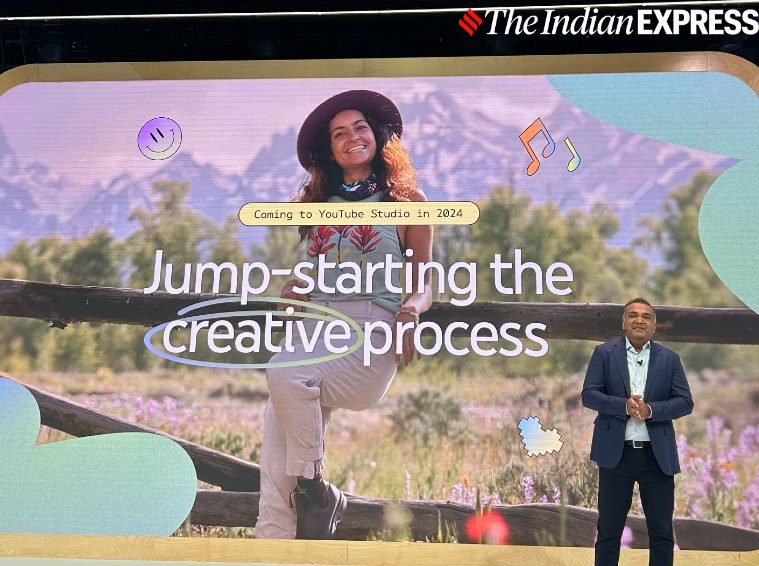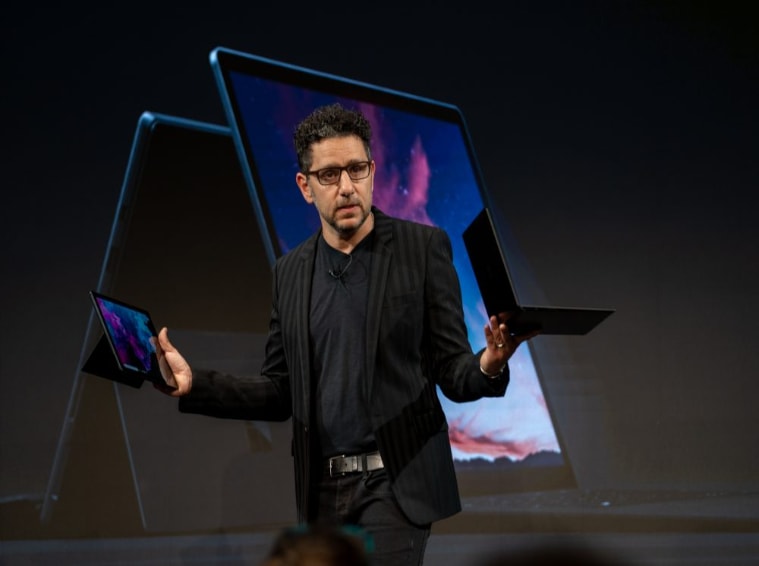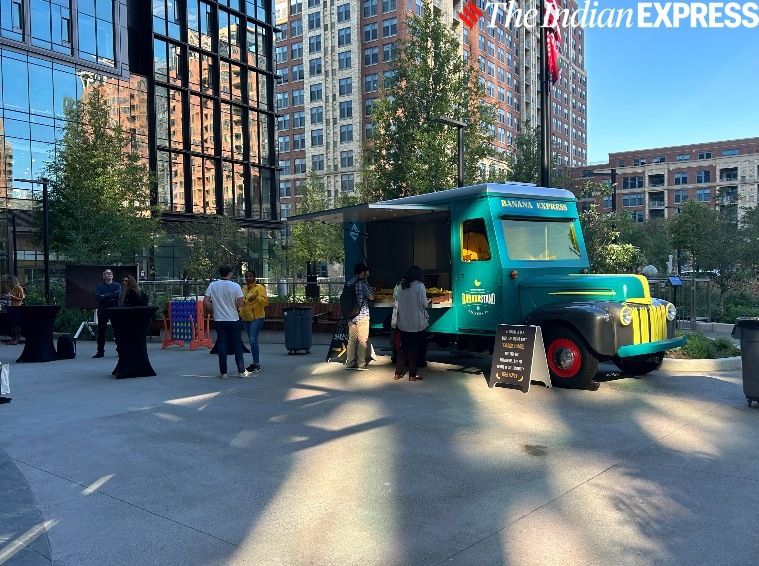Despite the new Echo Show and Fire TVs, along with updated Echo Frames and a brand-new Echo Hub smart controller announced at last week’s Amazon event, a smarter version of Alexa, powered by generative AI, stole the show. Microsoft and YouTube’s fall events later that week were also centered around the theme of artificial intelligence. It’s no surprise that “generative AI” was everywhere during Big Tech’s fall product launch events this year.
Dave Limp, Senior VP of Devices and Services at Amazon, outlined how “generative AI is going to be the foundation of what drives the next step function in ambient intelligence” when revealing that an all-new Alexa voice assistant will be powered by its new Alexa large language model. Similar sentiments were echoed during the “Made on YouTube” event in New York when YouTube CEO Neal Mohan said they “want to make it easier for everyone to feel like they can create” and “believe generative AI will make that possible.” At Microsoft’s special Surface event in New York, CEO Satya Nadella clearly positioned the company as the AI leader, with its range of products now powered by generative AI. “I mean, it’s crazy,” he said. “It’s kind of like the ’90s are back.”

By all accounts, the buzz around Generative AI is hitting a peak. Announcements from Amazon, Microsoft, and YouTube during their fall events outline the rate of progress these major tech behemoths have made in artificial intelligence, and everybody wants to demonstrate the real use cases of AI through the applications that will impact both consumers and businesses.
 The all-new Echo Show 8 has a refreshed look, faster Alexa, adaptive home screen, and spatial audio.(Image credit: Anuj Bhatia/Indian Express)
The all-new Echo Show 8 has a refreshed look, faster Alexa, adaptive home screen, and spatial audio.(Image credit: Anuj Bhatia/Indian Express)
“We are finding that using LLM enables us to innovate more quickly for customers,” responded Eric Saarnio, Vice President of Amazon Devices International when asked by indianexpress.com whether generative AI will have the same impact as software updates when brands push them to improve existing devices. During its fall event, Amazon announced that the generative AI update for Alexa will be available for all Echo products dating back to 2014. “Because Alexa is based in the cloud, all the processing is done there. This allows us to make those interactive updates, and a software update isn’t necessarily required,” he said.
The e-commerce giant used its annual fall event primarily to relaunch Alexa, its voice-based personal assistant introduced a decade ago. Amazon was an early player in the artificial intelligence race when it introduced Alexa on its Echo smart speakers. However, the technology that powered these voice assistants wasn’t as mature as it should have been, and as a result, Alexa and competing assistants were replaced by AI-powered bots, such as ChatGPT and Google Bard. People have been using ChatGPT to handle complex tasks like coding software, writing fiction, and drafting emails, leaving Alexa redundant. That, however, changed with the new Alexa, which will be able to resume conversations without a wake word, respond more quickly, learn user preferences, and maintain context.
“When it comes to AI today, the industry… [is] focused on how to apply generative AI to phones and browsers,” Limp said. “Again, that makes a lot of sense because that is where customers are. But today, generative AI has been primarily focused on creators, not consumers. But when you are building an AI like this for the home, you have to think about it very, very differently.”
 Neal Mohan, YouTube’s new CEO, at the “Made on YouTube” event in New York. (Image credit: Anuj Bhatia/Indian Express)
Neal Mohan, YouTube’s new CEO, at the “Made on YouTube” event in New York. (Image credit: Anuj Bhatia/Indian Express)
Limp didn’t discredit what ChatGPT stands for and how it brought excitement around chatbots, but he did point out that the most generative AI applications are for content creators and not for everyday consumers. Some may dismiss Limp’s comments, but AI chatbots like ChatGPT do let users create new things. Alexa, on the other hand, is very much focused on consumption-heavy consumers and leans heavily on the smart home. So clearly Amazon thinks there is a distinction between ChatGPT and Alexa, even though both are powered by what are known as large language models, which are systems trained to recognise and generate text based on enormous data sets scraped from the web.
Story continues below this ad
While the superpowered Alexa was the star of Amazon’s fall product announcement event, observers felt the new hardware was mostly incremental upgrades to the tech giant’s popular products, barring the new Echo Hub smart home controller. There were no surprises, unconventional products, or even updates to Kindle and Astro robot. Many felt the hardware announcements were “dull” and completely “underwhelming.” Amazon isn’t known for making short strides, and that makes us wonder what happened to the company’s ambitions to dominate the devices side. With Limp planning to retire in the coming months amid cutbacks and layoffs at Amazon, both the hardware and Alexa divisions have been severely impacted. It is unclear whether Amazon will even make niche or experimental hardware going forward, but devices are still important for Alexa’s domination in the smart home race.
 Microsoft Chief Product Officer Panos Panay, who helped create the Surface line, left the company last week. (Image credit: Microsoft)
Microsoft Chief Product Officer Panos Panay, who helped create the Surface line, left the company last week. (Image credit: Microsoft)
A similar observation was also seen during Microsoft’s special event for Surface and AI last week. All the focus was on Copilot, Microsoft’s new AI-powered assistant which is getting fully integrated into Windows and the AI future of the desktop operating system, even as very little time was spent on the Surface hardware. In fact, 90 per cent of the keynote was dedicated to AI-based announcements, and Surface was reserved for just the final 15 minutes. At a New York event, Microsoft announced the Surface Laptop Studio 2 and the Surface Laptop Go 3, but both of these announcements were nothing extraordinary. The “wow” factor seems to be gone, especially without Panos Panay – the public face of the Surface computers for at least a decade – who left Microsoft three days before the event. Panay hasn’t announced his next move but reportedly he could lead Amazon’s hardware division.
Panay’s sudden exit from Microsoft may shock people, but there were already signs that the company had been less “pumped” about its “experimental” Surface PC line amid declining sales. Microsoft says it’s still committed to the Surface PCs, but the truth is the devices business is a small part of Redmond’s overall revenue. Microsoft has had a series of flop devices in recent memory, including the much-hyped Surface Duo dual-screen tablet/smartphone, which failed to generate consumer interest. It’s clear that the only thing that’s driving Microsoft to scale back its hardware ambitions is the need for products that are popular and making money. The question is whether new launches can revive Surface PC sales amid a global economic slowdown and competition from Apple.
Microsoft may still want to be in the hardware business, but as a company, it is clearly going all-in on “generative AI.” The spotlight on AI technologies and AI-powered enhancements coming to Windows 11 later this month shows where Nadella wants to take Microsoft in the future. Its billions of investment in OpenAI – the startup behind the viral ChatGPT and incorporating its technology into the Bing search engine as well as other products – is a sign that Microsoft will be committed to AI in the near future.
Story continues below this ad
 Amazon’s held its fall event at its new campus in Arlington, Virginia. (Image credit: Anuj Bhatia/Indian Express)
Amazon’s held its fall event at its new campus in Arlington, Virginia. (Image credit: Anuj Bhatia/Indian Express)
Google is equally a part of Big Tech’s latest fascination – to be at the front of the brewing generative AI race. The company has already shown off technologies related to “generative AI” and incorporated them into many of its core products, including Bard and Search. Last week, it made the move to bring “generative AI” experiences to YouTube at its flagship event in New York. One of the new generative AI features dubbed “Dream Screen” – designed for its short-form videos – is an experimental feature that lets creators add AI-generated video or image backgrounds to their vertical videos.
The “Dream Screen” editing feature was a precursor to how fast generative artificial intelligence continues to evolve, and we are going to see more in this space in the coming months. Which explains why generative AI was a widely discussed topic in YouTube’s content creator-centric event. “We view them as tools that are in the hands of creators, and it’s about enhancing human creativity with AI as opposed to replacing it,” Mohan said.



 The all-new Echo Show 8 has a refreshed look, faster Alexa, adaptive home screen, and spatial audio.(Image credit: Anuj Bhatia/Indian Express)
The all-new Echo Show 8 has a refreshed look, faster Alexa, adaptive home screen, and spatial audio.(Image credit: Anuj Bhatia/Indian Express) Neal Mohan, YouTube’s new CEO, at the “Made on YouTube” event in New York. (Image credit: Anuj Bhatia/
Neal Mohan, YouTube’s new CEO, at the “Made on YouTube” event in New York. (Image credit: Anuj Bhatia/ Microsoft Chief Product Officer Panos Panay, who helped create the Surface line, left the company last week. (Image credit: Microsoft)
Microsoft Chief Product Officer Panos Panay, who helped create the Surface line, left the company last week. (Image credit: Microsoft) Amazon’s held its fall event at its new campus in Arlington, Virginia. (Image credit: Anuj Bhatia/Indian Express)
Amazon’s held its fall event at its new campus in Arlington, Virginia. (Image credit: Anuj Bhatia/Indian Express)





